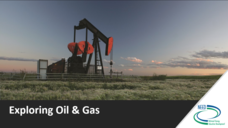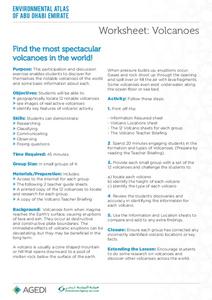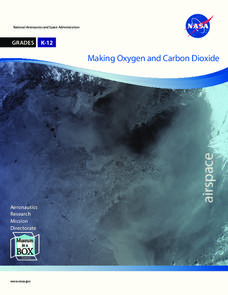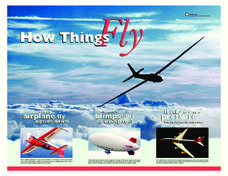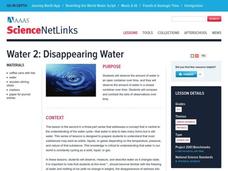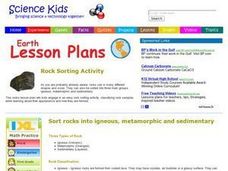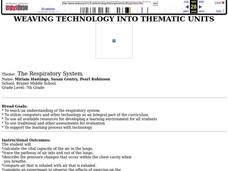Curated OER
Balloons: Math with the Montgolfier Balloon
Students discover the history of hot air balloons by watching one ascent. In this physics lesson, students utilize a Montgolfier Hot Air Balloon from an earlier lesson and record the temperature, rate of ascent and the volume....
NOAA
Climate, Weather…What’s the Difference?: Make an Electronic Temperature Sensor
What's the best way to record temperature over a long period of time? Scholars learn about collection of weather and temperature data by building thermistors in the fourth installment of the 10-part Discover Your Changing World series....
Rhythm Rhyme Results
Whatʼs the Same and Whatʼs Different?
Learn about radiation, convection, and conduction with a multiple choice worksheet. Each question prompts kids to decide what is different about each form of heat energy transfer, and what is the same.
Chicago Botanic Garden
Causes and Effects of Climate Change
It's time for your class to literally show what they know! Pupils illustrate what they learned about the causes and effects of climate change by filling out a graphic organizer to complete the 5-part series of lessons. They discuss them...
Curated OER
Wind
Students complete activities to study wind intensity. In this wind study lesson, students discuss wind speed and direction. Students then build a kite and windsock to help them study wind intensity. Students learn to use a wind meter for...
Curated OER
What's Up With Updrafts?
Students demonstrate how hail and rain are suspended in the air during a storm. In this lesson on storms and weather, students use a hair dryer and ping pong ball to demonstrate how hail and rain can be suspended in the air during a storm.
Curated OER
Refrigeration Part 2 - How they work
Fourth graders investigate insulators and how refrigerators actually work to keep things cold through evaporation and pressure changes in the coolant. They create a box to keep an ice cube from melting, and observe a variety of...
Curated OER
Comparing Solids, Liquids, and Gases
In this solids, liquids and gases learning exercise, students observe a teacher demonstration about gases and they experiment with liquids to show diffusion, shape and volume. They answer nine questions about the experiments related to...
Curated OER
How Pollution Disrupts Our Natural Environment
Students conduct experiments to illustrate global warming. In this air pollution instructional activity, students first examine how a layer of greenhouse gasses might impact the earth's atmospheric temperature, then evaluate how the...
Curated OER
It's Clean, Fresh and only Three Billion Years Old - Water!
Learners engage in a lesson which explores the wate cycle. They get to see some very entertaining video, do fun hands-on activities and gain a better understanding of evaporation, condensation, precipitation and collection.
Curated OER
The Effects of Storms
An excellent way to review a chapter or unit on storms, this worksheet features vocabulary review (gust, evacuation, storm surge, salinity), concept review (effects and details about hurricanes), skills/process review (normal high tide...
Curated OER
The Goldilocks Principle: A Model of Atmospheric Gases
Students discuss the characteristics of the Goldilocks Principle. They discover the pressure and chemical composition of Venus and Mars. They discuss how the Earth's temperature is affected by the atmosphere.
National Energy Education Development Project
Exploring Oil and Gas
The United States consumes more oil than any other country, about 1.85 billion barrels (or 77 billion gallons) a day. Viewers learn about the history of fossil fuel exploration and how they are formed in an informative presentation. They...
Environment Agency - Abu Dhabi
Find the Most Spectacular Volcanoes in the World!
Heat things up in your earth science class with this collaborative lesson on volcanoes. After first being introduced to the different types of volcanoes and how they are formed, young geologists work in small groups to...
NASA
Making Oxygen and Carbon Dioxide
Some like it hot! Scholars observe both exothermic and endothermic reactions as part of the carbon dioxide oxygen cycle. First, scientists demonstrate (or watch) a chemical reaction to create pure oxygen using fire for...
Council for Economic Education
GDP Data: Is the Economy Healthy?
Does the economy needs a check-up? Scholars analyze the gross domestic product (GDP) to determine the overall health of the current economy. They use a short video clip as well as economic data to determine the current growth of the...
Curated OER
You Can Be A Woman Meteorologist
Students complete four activities that are about meteorology. The first activity is for them to explore weather maps. The second activity is for students to discover high-pressure and low-pressure air. The third activity is for them to...
Curated OER
How Things Fly
Young scholars explain basic principles of aeronautics such as gravity and lift. In this How Things Fly lesson, students visit the interactive, hands-on How Things Fly gallery at the Smithsonian. Young scholars perform three experiments...
Curated OER
Review For Weather Quiz 2
In this science worksheet, students look at the information carefully in preparation for a formal assessment. The focus is upon defining different aspects of air masses.
Curated OER
Alice World:Tornado
Seventh graders use the Alice program and complete a world that is damaged after a tornado. In this atmospheric conditions lesson students complete an activity using the Alice program.
Curated OER
Disappearing Water
Students explore the water cycle. For this earth science lesson, students observe and measure water in a closed container and in an open container. Students record their observations and compare their sets of data to draw conclusions...
Curated OER
Rock Sorting Activity
Students organize rock samples according to their properties. In this earth science lesson plan, students predict whether they are igneous, metamorphic or sedimentary. They compare their prediction with the actual type.
Curated OER
Weather Art in Space Settlements
Students demonstrate a cloud formation and the relation between pressure and temperature in gases. They explain how clouds could be created in space settlements and see the relation between pressure and temperature in gases.
Curated OER
The Respiratory System
The student will calculate the vital capacity of the air in the lungs and trace the pathway of air into and out of the lungs. They describe the pressure changes that occur within the chest cavity when you breathe. They compare air that...














